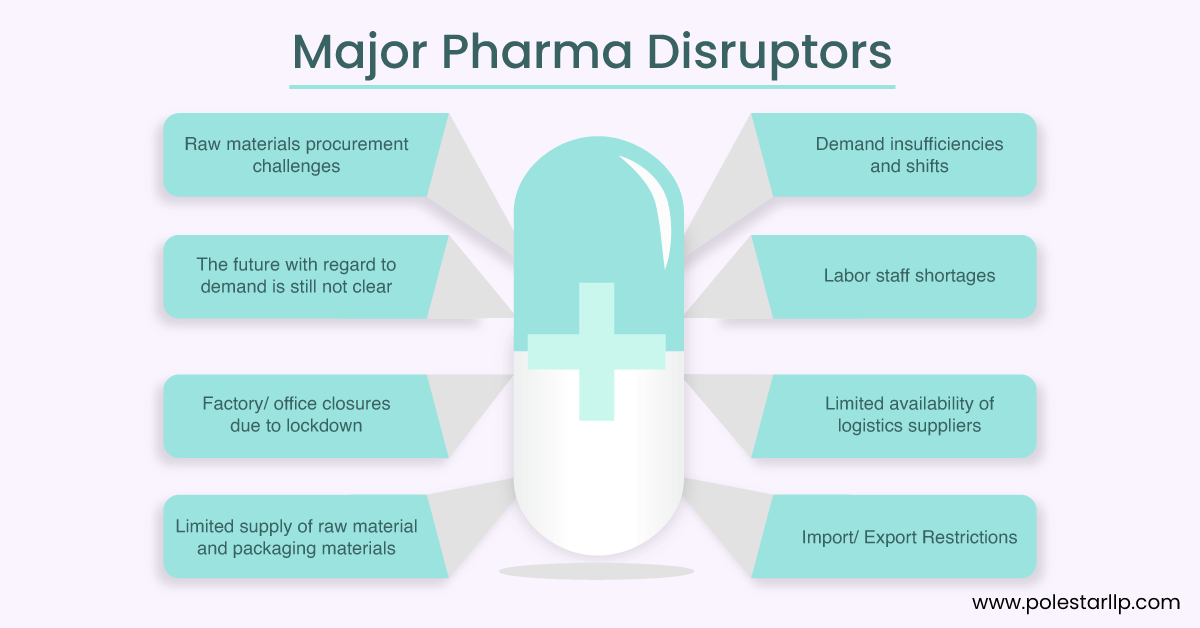
Sign up to receive latest insights & updates in technology, AI & data analytics, data science, & innovations from Polestar Analytics.
In the past few weeks, Covid19 has severely impacted organizations across the globe. The pharmaceutical industry is similarly reeling from the impacts brought about as a result of the pandemic driven lockdowns. A crisis management plan and strategy has become critical to ensure continued business success for pharma companies.
More than 1/3rd of the global population is under tight lockdowns and in other places limitations to various degrees are in place. Because of this, the supply-chain has been severely impacted.
In his best-selling 2007 book about unpredictable events, "The Black Swan," mathematician Nassim Nicholas Taleb explained that Black Swan events have three aspects:
First, it is an outlier, as it lies outside the realm of regular expectations, nothing in the past can convincingly point to its possibility.
Second, it carries an extreme 'impact'.
Third, despite its outlier status, human nature makes us concoct explanations for its occurrence after the fact, making it explainable and predictable.
A common feature with black swan events is that they have a massive impact on businesses and can often pivot and amplify around certain blind spots that may exist within the organizations.
Covid-19 has emerged as a Black Swan event for pharmaceutical organizations - with critical implications on manufacturing, diversification, channel and R&D strategies. The crisis has uncovered uncertainties in the market and it is forcing these business leaders to make decisions under uncertainty, rethinking their production and bringing about cost-cutting measures.
In this blog, we will take a look at some crisis management techniques that will help to uncover these blind spots and design effective crisis management in both the short and long term.

There are several disruptors today, and businesses need to adapt and respond.
Pharmaceutical companies are pondering multiple questions -
1. How to fulfill demand subject to current constraints?
2. What is the impact on revenue as a result of export curbs/ supply chain bottlenecks?
The traditional approach to crisis management planning works along the following lines
# ASSESSING RISKS.
# DETERMINING THE BUSINESS IMPACT WITH FORECAST MODELS
# IDENTIFYING CONTINGENCIES.
# BUILDING THE PLAN.
# FAMILIARIZING USERS.
# REVISITING THE PLAN REGULARLY
Today, this framework cannot work. There are too many external and dynamically changing variables that will render such a model obsolete once it travels through this process from inception until communication to the frontline managers.
By exploiting multiple data points and building an integrated strategy on top, managers can mitigate the damage that results from black swan events and other risky blind spots. The caveat: organizations need to rely less on management experience and intuition, instead of acting by relying on an integrated data strategy to point to potential risks.
Crisis management with agile planning is the need of the hour today to respond proactively, save costs and make workforce planning.
Decision-makers are now more in need for an integrated view of the business, honed with the use of data analytics.
Businesses should embrace cross-functional and agile planning & response frameworks.
With a data-driven and collaborative approach, pharma companies can minimize supply chain disruptions by identifying the weaknesses and by taking proactive corrective measures with the help of trustworthy and decisive insights.
A data-driven and connected planning approach will also help organizations to model working capital levers to assess the cash-flow impact and preserve liquidity and mitigate exposure by analyzing contract obligations.
According to Ronald Kenett, an experienced Operational Risk manager
"Risk management is traditionally practiced using subjective assessments and scenario-based impact analysis. This common approach is based on experts providing their opinions and is relatively easy to implement …. Modern evidence-based management relies however on data, and not only opinions, for achieving effectiveness and efficiency. In that context, risk management can exploit information from structured quantitative sources (numerical data) and semantic unstructured sources (e.g. text, voice or video recordings) for driving risk assessment and risk mitigation strategies."
An agile and connected crisis management plan to planning will bolster traditional planning methodology.
The forecast will not only become more accurate, but it will also come with the ability to dynamically add internal and external drivers and integrate them into the planning model to assess the impact from rapidly changing market scenarios.
Such an approach will help to bring the planning cycle in real-time to reduce the adverse impact on the company's bottom line.
By taking multiple input parameters in real-time into the model, planning managers can run simulations on rapidly changing scenarios and deploy evidence-based corrective actions for cost savings and success.
It will provide decision-makers with the foresight to determine the business impact of each micro-event on the company bottom line, identify contingency measures as well as familiarize others within the organization.
Information sharing and inter-connectedness will provide visibility to other teams as well to assess the impact of their forecasts on other departments.
However, developing and integrating such a dynamic approach into the organization workflow requires the right platforms. Organizations will need to overhaul their planning process, from the traditional forecasting completely.
Anaplan is a cloud-based, connected planning platform across sales, marketing, merchandising, supply chain, finance and workforce planning; that provides real-time access even while working remotely.
The solution is stable and scalable while coming with periodic updates, without you having to rely on your IT team. It helps to eliminate spreadsheets or point solutions for planning, which are difficult to collaborate and rely upon.
Our webinar on crisis management will take you through the best practices along with solution demos to help you understand how to integrate a data-driven and connected planning approach across your finance and supply chain.
Our demo will focus on how you can pick up early warning signals, test assumptions, and predict the course of action based on an assessment of supply chain and finance variables such as supplier finance risks, variable input costs across the value chain, etc.
With Anaplan's scenario-based planning capabilities, you will learn how to project the associated financial impact. Plan better across critical areas related to demand forecasting, production planning, raw material planning and demand fulfillment and take corrective actions.
So, register and learn how to integrate agile and connected data-driven planning across the organization with a single source of truth to assess trends and make proactive strategies.
If you liked this blog, you might like our Latest Whitepaper as well. Get Your Free Copy Now.

About Author

Insights Explorer
If data is oil, then analytics is the combustion engine of this current era.